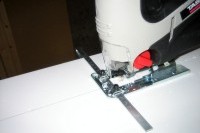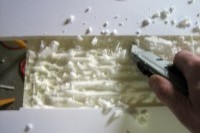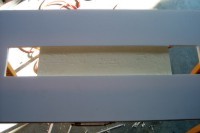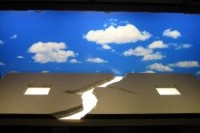
Base
Lest anyone think the previous version of the layout was a complete bust, there were a number of lessons learned that would be repeated. The base was again made from two layers of half-inch thick Gatorfoam, a denser, moisture-proof form of the more widely-known Foamcore. A single 34 by 40 inch sheet yielded the two pieces required to make the base. I rounded the two front corners to create a more finished look.
Although Gatorfoam can be cut with a sharp utility knife, it takes quite a bit of elbow-grease owing to the dense surface, so I elected to do the cutting with a saber saw fitted with a fine-tooth blade. After cutting, I smoothed the edges with a sanding block.
Before laminating the two sheets together, I carved a slot into the underside of the top sheet to serve as a wire conduit. The slot connects two square holes cut roughly in the middle of each helix. The previous version of the layout had no such feature, and it created some grief when it came to wiring. (Running the wires on the underside of either layout was never an option.)
The sheets were laminated with extra-heavy-duty spray adhesive. Previously I'd used polyurethane glue (such as Gorilla Glue) which, even under weights, caused some problems as it expanded. With the large surface areas involved, the spray adhesive is strong enough.
A couple of layers of conventional foamcore laminated to the base completed the layout's "benchwork." These additional layers are black foamcore so that the tunnel areas would not need to be painted.

A saber saw with a fine-tooth blade makes quick work of cutting the board.

A wiring access slot is carved out from the underside of the top base sheet.

The slot is sanded smooth to prevent any wires from snagging.

The base is finished and ready for the roadbed.
Copyright © 2007-2013 by David K. Smith. All Rights Reserved.